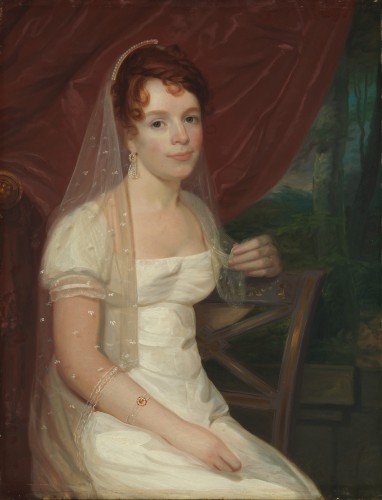John Wesley Jarvis

Mrs. Robert Dickey (Anne Brown), 1807–10
John Wesley Jarvis (1780 – 1840)
A portrait painter in New York, John Wesley Jarvis was born to parents in South Shield, England, and was a nephew of theologian John Wesley. At age five, he was brought to Philadelphia where the family first settled. He was apprenticed to Edward Savage, portrait painter and engraver, and in 1801 Savage moved to New York City and brought Jarvis with him and for awhile they worked together.
However, the men became estranged and Jarvis opened his own engraving business and then formed a partnership with Joseph Wood. “Their business was so successful that, Jarvis later claimed they often took in more than $100 a day.” Because there was little competition, Jarvis’s reputation soared as a portraitist. He later said: “I was the best painter because others were worse than bad—so bad was the best.”
The Jarvis-Wood partnership ended in 1810, and that year was one of travel for Jarvis. He went to Baltimore and Charleston in search of portrait commissions, and by 1820 was working in New Orleans. Some of his most important works were full-length military figures from the War of 1812 for the City Hall of New York.
Jarvis was popular in Knickerbocker society, where he had a close friendship with Washington Irving and painted his portrait. He was known for his boisterous stories and jokes and love of food and drink. He was not a member of either the American Academy of Design of the National Academy of Design but did enter their exhibitions.
Towards the end of his life, he suffered extreme poverty and a stroke in New Orleans led to his death in New York City in 1840.
Sources include:
David Dearinger, Editor, Paintings and Sculpture in the Collection of the National Academy of Design, 1826-1925, pp. 316
Biography from the Archives of AskART